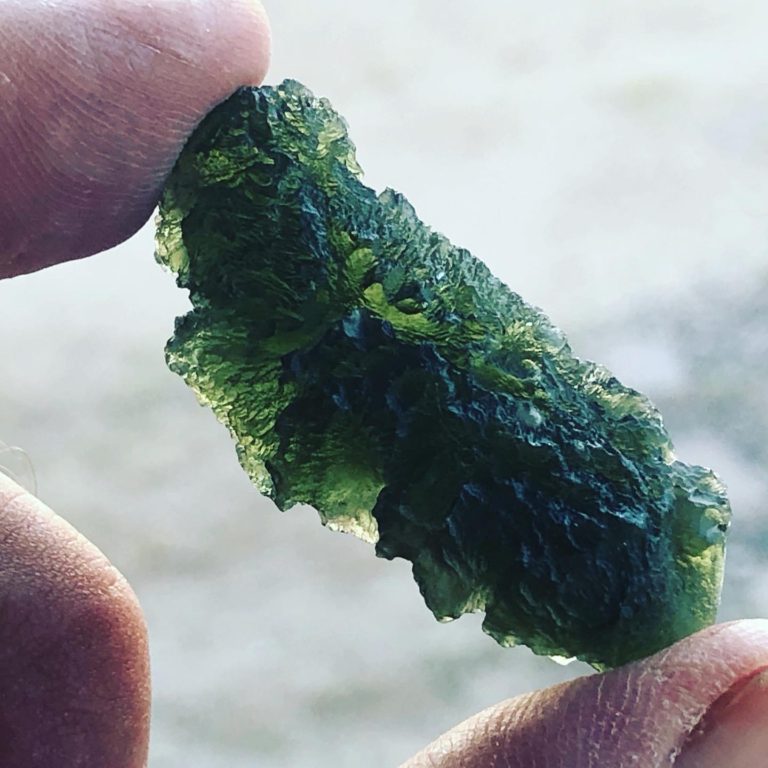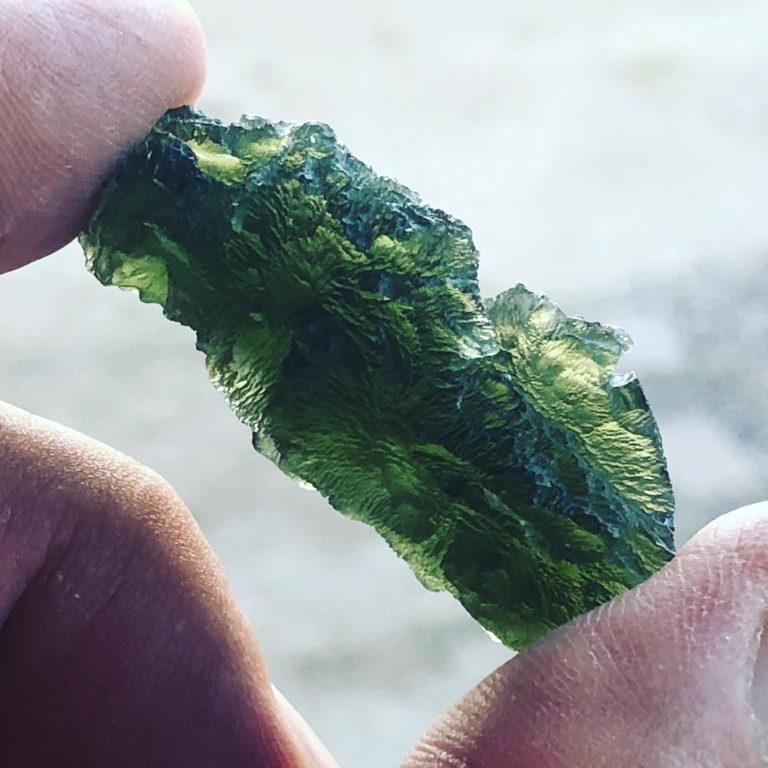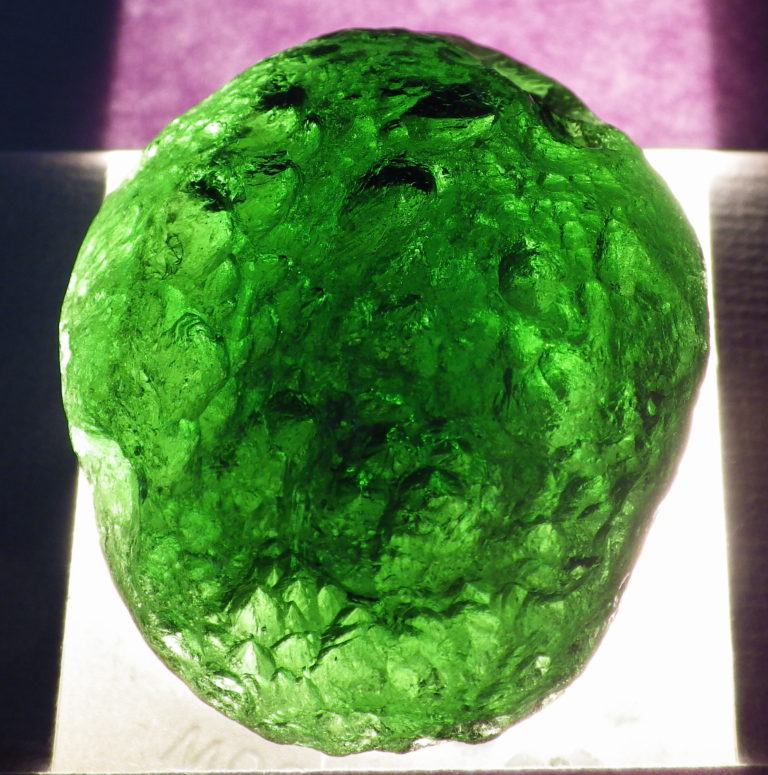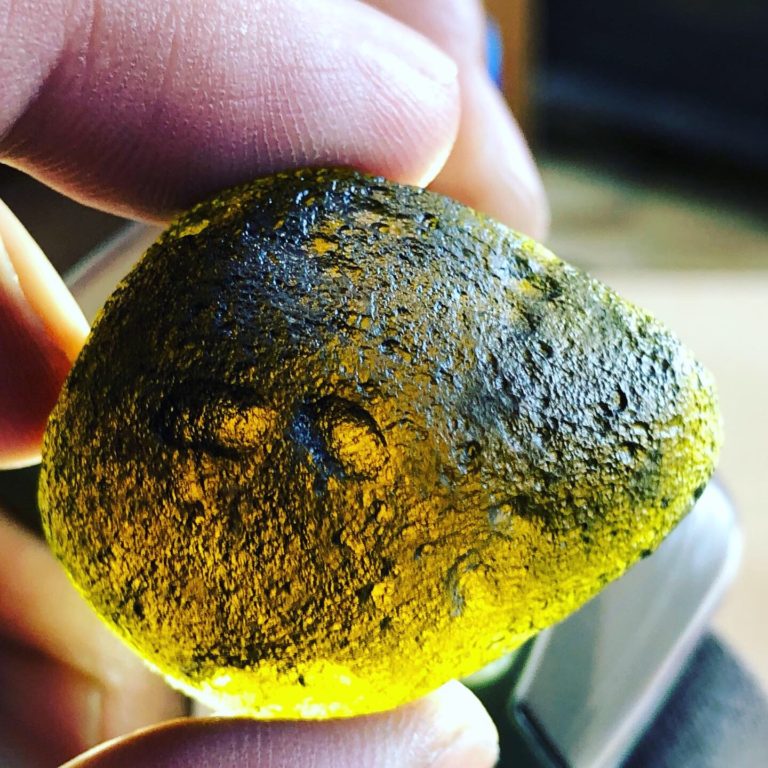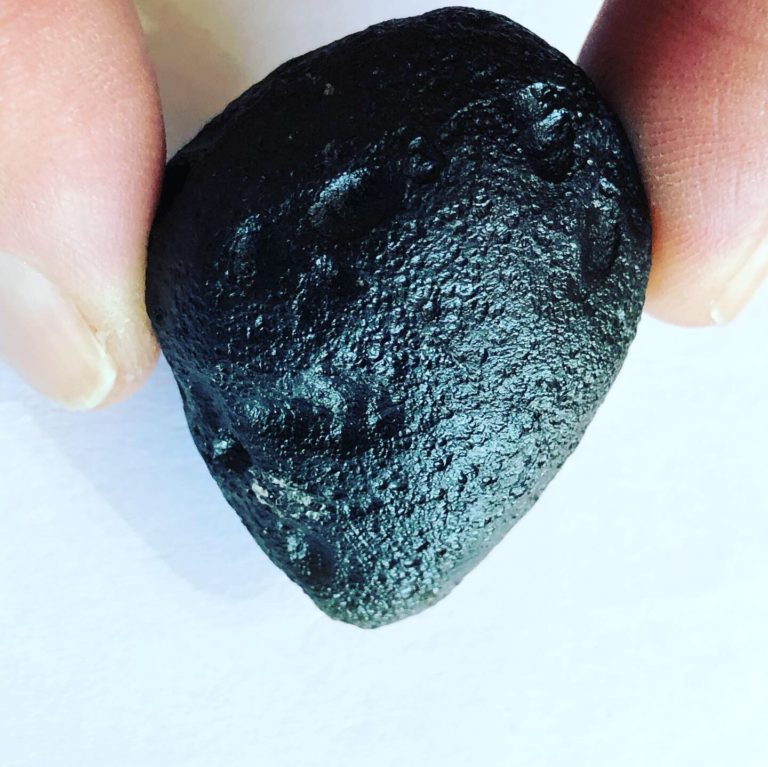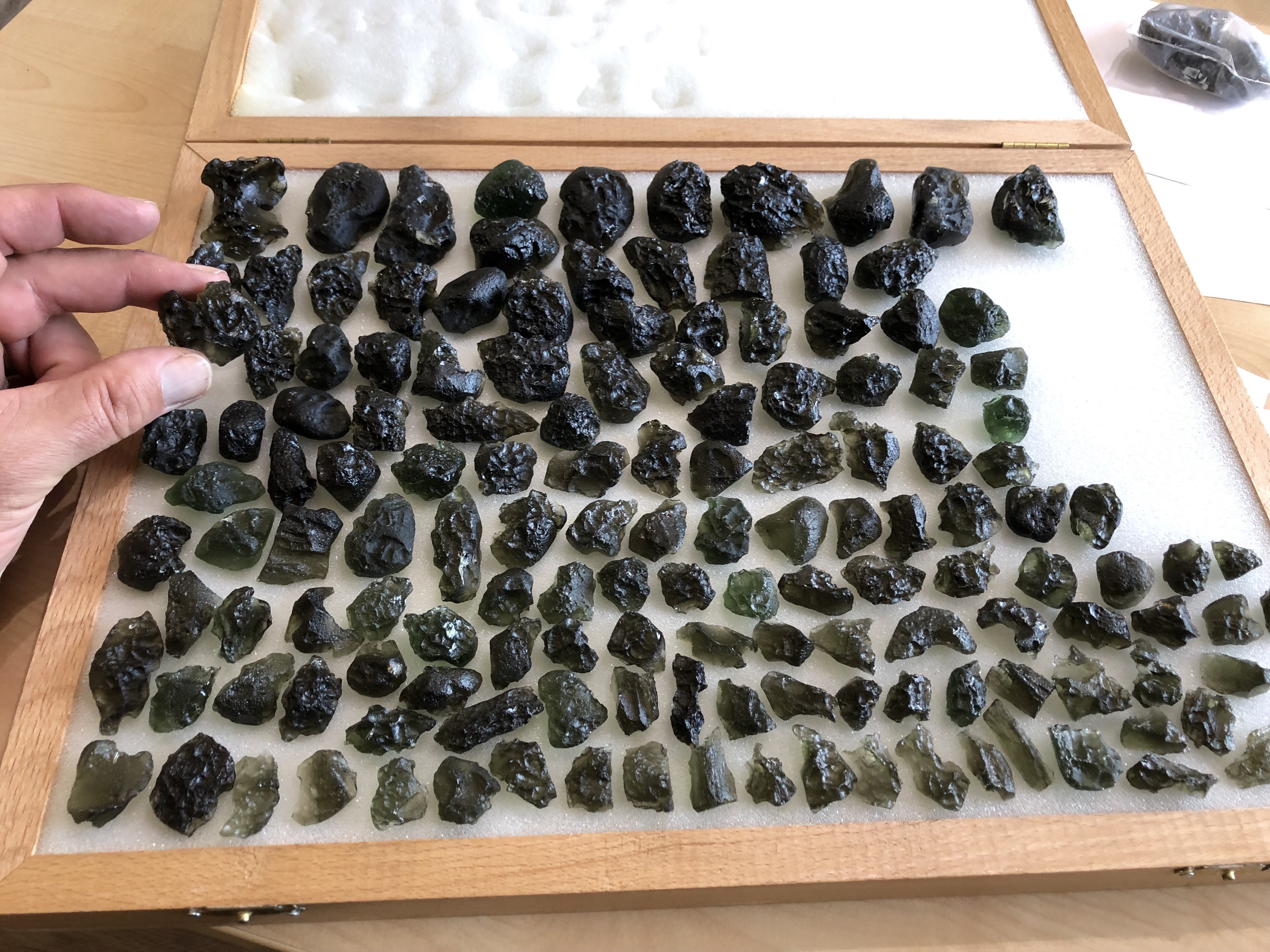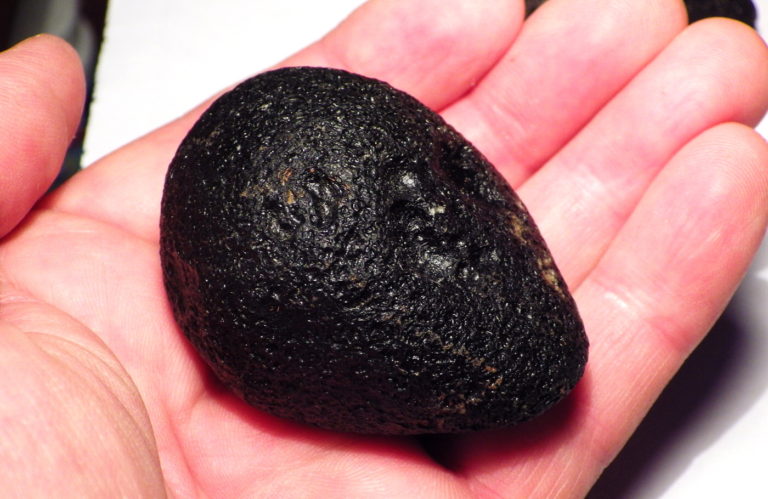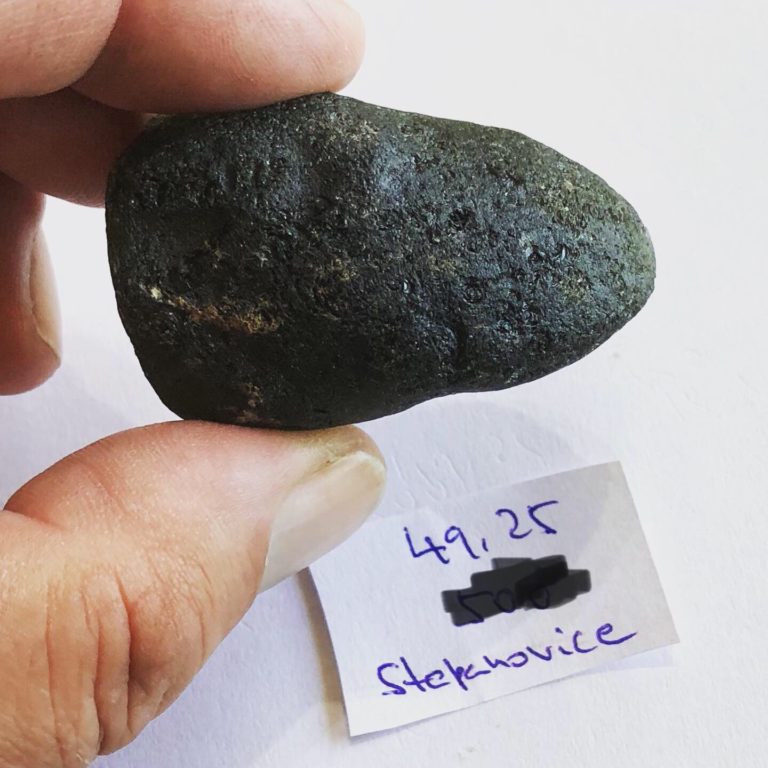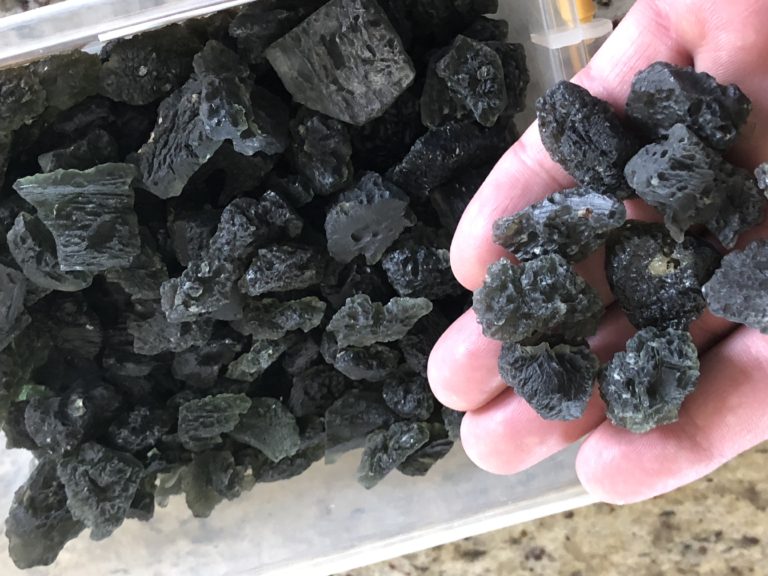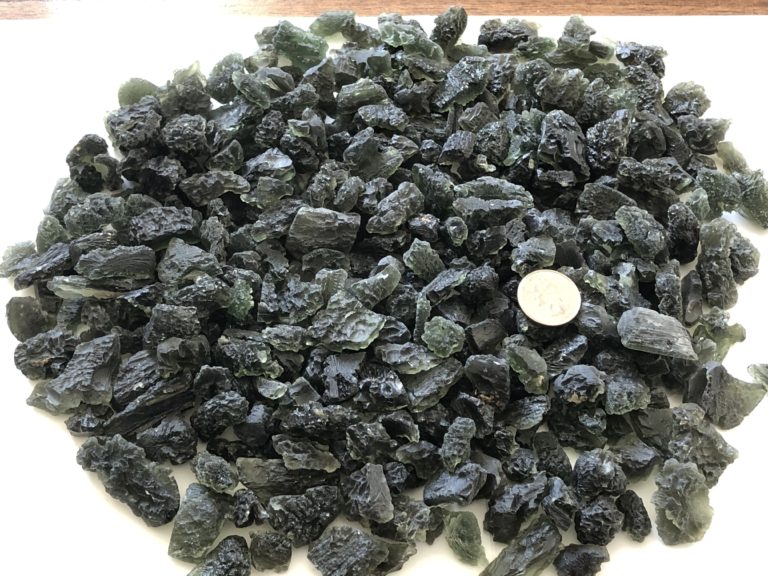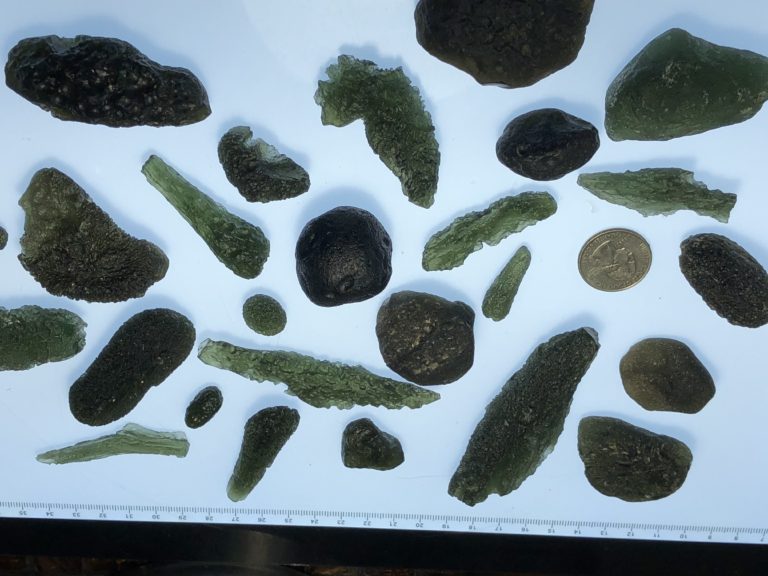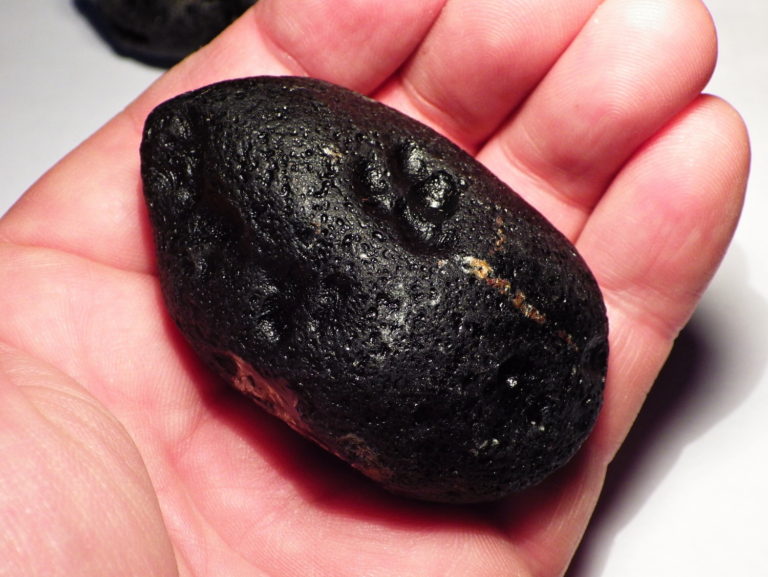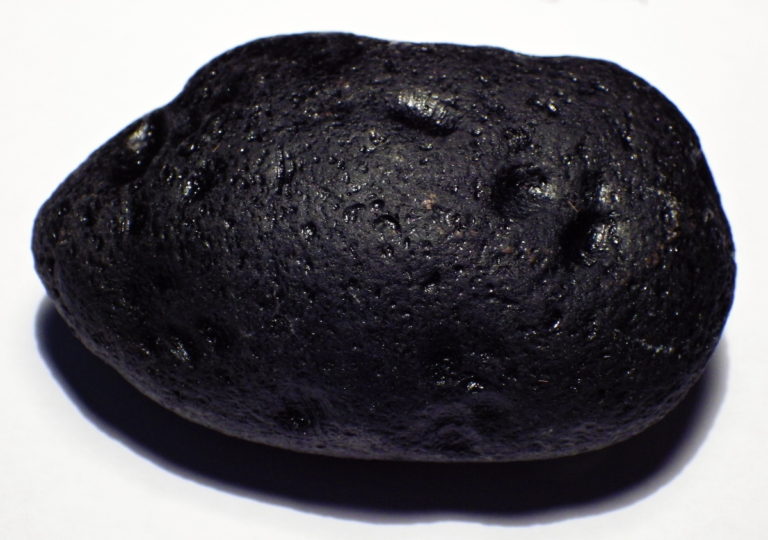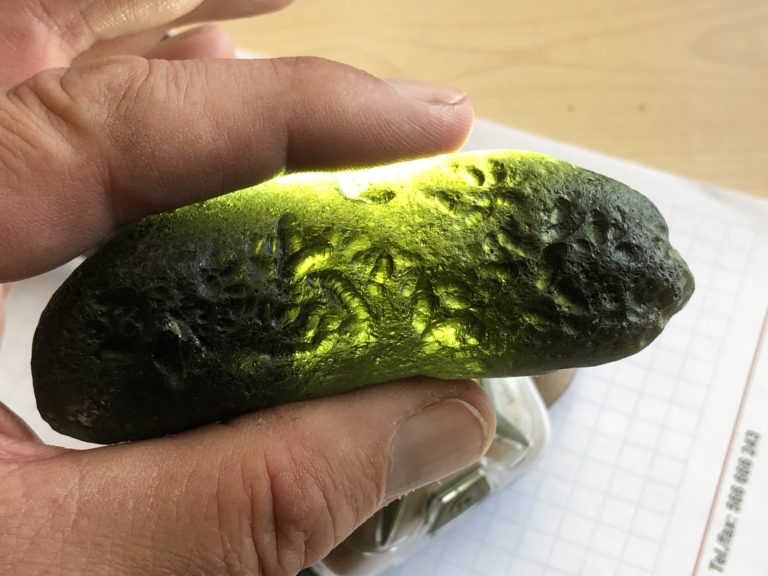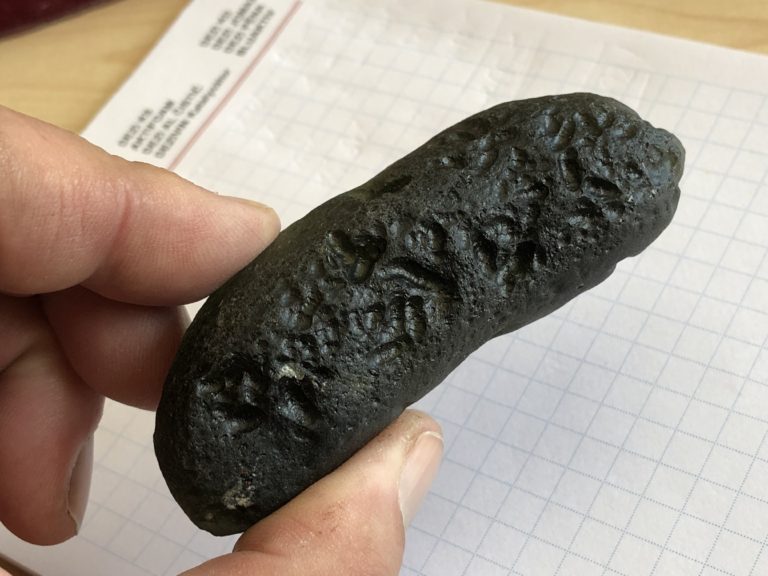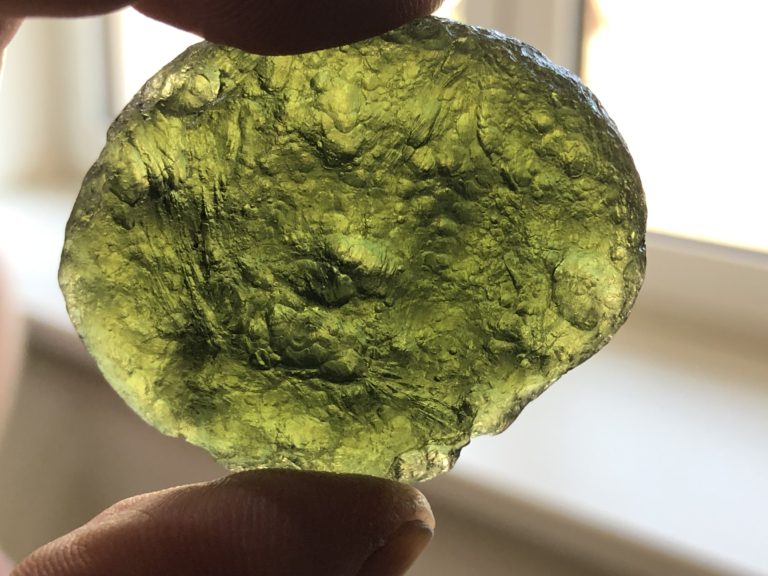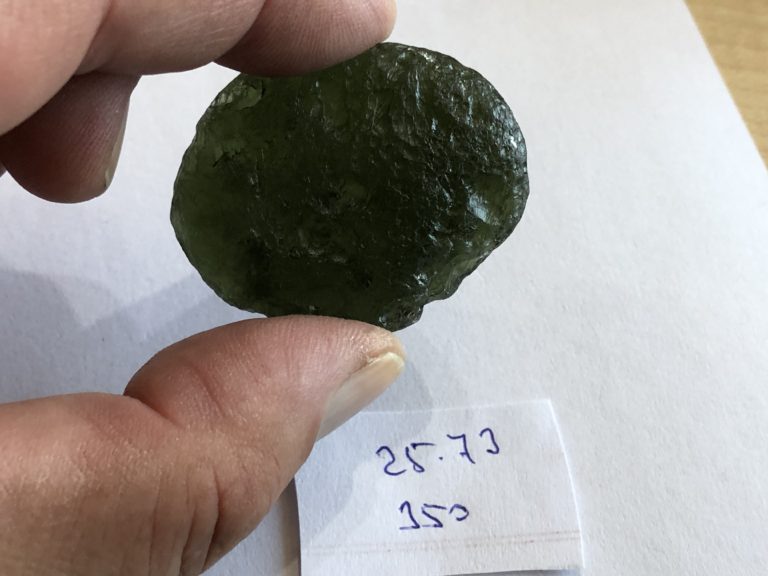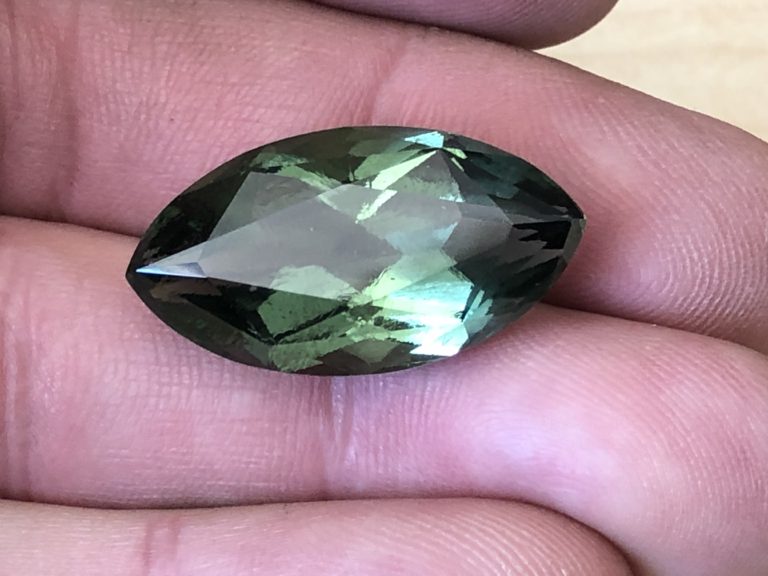GET EDUCATED BEFORE YOU BUY YOUR NEXT GEM!
BUYING AND INVESTING IN NATURAL MOLDAVITE
By Ales Patrick Krivanek, Ravenstein Gem Co. and SAINT CLAIRE Finest Gems, December 2014
WHAT is MOLDAVITE?
Let me start with a simple fact: Moldavite is one of the rarest stones on earth! Moldavite is a true space origin gemstone, found in 4 separate strewn fields, all located in the small European country of Czech Republic.
Two major strewn fields are located in Southern Bohemia (from which about 99 percent of ALL Moldavite comes from), Moravian strewn field, offering the largest, rarest and most unique pieces, and Cheb basin strewn field near border with Germany, which produced only a very limited number of Moldavite and is practically depleted since 2007. Few pieces of Moldavite were discovered near town of Dresden in Germany but these finds are loosely connected to the Cheb basin strewn field and is not considered to be a separate location. About 15 pieces of Moldavite were found across the southern border with Austria, near the towns of Radessen and Altenburg, but again, those are a simple extension of the Moravian strewn field.
Chemically, Moldavite is nearly a pure silica with traces of aluminum oxide, potassium oxide, iron oxide, magnesium oxide, calcium oxide and sodium oxide. Very interesting is the fact that Moldavite also contains rare trace elements like rubidium, cesium and barium.
Moldavite belongs to the family of Tektites. A very unique family of stones of up to date unexplained origin. What sets Moldavite apart from other tektites is its breathtaking color and nearly perfect clarity. Typical colors of Moldavite range from very light green, grass green, apple green, bottle green through olive green to green-brownish.
There is one single approx. 3 gram piece of pure blue Moldavite discovered about 6 years ago near town of Moravske Budejovice, Southern Moravia. This piece remains in private hands of the lucky person who found it and value of this rich blue gem is simply astronomic. I was first person who confirmed legitimacy of this find and Im proud to share a photograph of the worlds only blue Moldavite right here in this Buying Guide.
MOLDAVITES and ME
Since I was born in Czech Republic (Czechoslovakia back then) I became obsessed with Moldavite ever since I was a young lad. I frequently visited local museum in town of Jihlava and spent countless hours studying all the different Moldavites on display, their intrigue shapes, fascinating surface and beautiful colors. I could not get enough.
When I was 14 my parents let me take the train to the near by town of Trebic to realize my very first “Moldavite hunting” trip. On this very same day I found the 8th largest Moldavite ever discovered…. a whooping 800 carat piece in pure deep green color and nearly perfect egg-shape. I was hooked (who would not…) and my plans of becoming a gem hunter were sealed.
Now, some 40 years later Im happy to share my expertise and knowledge about Moldavite with others. Enjoy!
WHAT MAKES MOLDAVITE SO UNIQUE?
One would think that with all the knowledge and testing techniques available today, there could be no surprises or unexplained origin stones on face this earth. Wrong! Moldavite is the only gem which consistently resists cracking its code of origin. Ever since it was officially discovered in 1786 in gravels from the Vltava River (Moldau in German), there were virtually dozens of theories created about its origin. Up to date, none of these can fully answer how this gem was actually created and Moldavite quietly rests in the miocene sediment deposits of Bohemia and Moravia as a total stranger who simply does not belong there.
One thing is clear. Moldavite was created completely, or at least partially in outer space. Facts supporting this are numerous:
Many Moldavites have shapes clearly suggesting it was formed in space (drops, spheres, discs, dumbbells, sticks…).
All Moldavites have vacuum bubbles, from microscopic sizes to a very large, over 1cm long. So Moldavite could not possibly be created under regular atmospheric pressure.
Some Moldavite have signs of so called “ablation” which can only be created by a high speed flight thru the atmosphere, when the front part of the stone is heated to the point of melting and creates sort of an acorn shaped edge.
Most recent studies proved beyond a shadow of doubt that Moldavite chemical composition is not linked to the impact crater Reis in Bavaria.
But this is not all what makes Moldavite so desirable. Total amount of Moldavite mined up to date is estimated to a very sober 400,000 individual pieces. Compare this low figure with a total number of diamonds, rubies, sapphires or any other highly valued gem on the market. There are tens or hundreds of millions of any of those. Yes, real genuine Moldavite is extremely, and let me repeat this EXTREMELY rare. So if you put two and two together, one does not have to be a genius to realize that owning a piece of Moldavite is a privilege, not a standard. Moldavite is one of the fastest growing gems in value, but even the most expensive pieces are still cheap compared to its rarity and low availability.
MOLDAVITE CREATION THEORIES
Well, let me start with this: There are simply too many to mention so let me concentrate on 4 most interesting ones. Still, none of these can fully answer the mystery of Moldavite “starborn” creation. Each has its strong points and each one has its weaknesses. I can not go into depth on these, this Guide would be simply too long, most people would never finish reading it. So here are some facts:
1. The Impact Theory
There is a very nicely thought out and very believable theory about Moldavite creation. According to this theory, Moldavite was created by a meteor or large comet impact. There is even a fairly well preserved meteor impact crater about 120Km east of Baden- Württemberg city of Stuttgart called Nördlinger Ries. The crater was created at about same time as Moldavite, that is some 14.7 million years ago during the miocene era. OK, so far so good.
But there are several facts which simply do not support this otherwise widely accepted Moldavite creation theory. The most recent and most disappointing for most supporters is the fact that most recent studies (2010-2013) has proven that chemical composition of Moldavite and chemical composition of the earth directly at the Reis crater simply do not match. Therefore the crater Reis is not the original source of Moldavite creation and we must look (once again) elsewhere.
There are other facts not exactly supporting this theory of one crater. Moldavite is found in 4 separate strewn fields, each with unique type of Moldavite with great differences in average weight, colors, shapes and type of surface. Such dramatic differences simply do not support theory of one impact crater.
And there is more speaking against this theory. All Moldavite has bubbles of near vacuum. This clearly suggests that these stones were actually created (or re-created) in the upper layers of atmosphere. Not at, or near the surface. If Moldavite was created at earth surface, level of vacuum would not be uniform in all pieces but would fluctuate greatly. Proponents of the impact theory claim, that the near vacuum was created by the big mass of the meteorite as it was flying by incredible speed throughout the atmosphere. So basically behind this huge flying rock, there was a super low pressure “tunnel” of “void” created. Yes, great, I agree… BUT the Moldavite was supposingly created by the FRONTAL part of this huge meteor, where the air was actually pushed like in front of a locomotive. So in my own opinion, most of the bubbles inside Moldavite would actually have to be pressurized above standard atmospheric pressure, NOT below. Well, I hope I did not loose you here.. almost lost myself since my English is really far from perfect… I promised not to go into much depth on these individual creation theories simply to avoid boring some of you to death, but you can do your own research on this subject and come to your own conclusions about the Moldavite creation.
2. The Glass Meteor Theory
Soon after Moldavites were first officially discovered, another believable theory was created by a famous Austrian mineralogist Dr. F. E. Suess. In 1902, Dr. Suess first pointed out that all tektites including moldavites regardless of origin / strewn field, exhibit strange surface features, which could not be due to the action of slightly acidic water over long periods of time, but rather resembled the characteristic markings found on many meteorites. This theory would explain why there are several different strew fields, each with different type of Moldavite, why most Moldavite have shapes corresponding with creation in space (or in upper layers of atmosphere), and why some Moldavites have signs of ablation.
3. The Lunar Origin Theory
In contrast to a terrestrial impact source for Moldavites or tektites in general, it was argued that tektites consist of material that was ejected from the Moon by major lunar volcanic eruptions and then drifted through space to later fall to Earth. From the 1950s to the 1990s, John A. O’Keefe argued for the lunar origin of tektites based upon their chemical, i.e. rare-earth, isotopic, and bulk, composition and physical properties. John A. O’Keefe, long-time tektite researcher Hal Povenmire, and meteorite and tektite collector Darryl Futrell claimed on the basis of behavior of glass melts that the homogenization of silica melts that characterize tektites could not be explained by the terrestrial-impact theory. They also argued that the terrestrial-impact theory could not explain the vesicules and extremely low water content in Moldavite and other tektites around the world. Further research of the actual Moon rocks brought back to Earth by the Apollo missions shifted away from this theory, nevertheless the Moon origin theory still have many proponents even today.
4. The War of Angels Theory (a non-religious people can simply skip this part)
Lets explore one rather mystical theory which claims that Moldavite is actual part of Angel of Light’s “Crown” or “Crown Jewel” scattered across the land of what is today Czech Republic, after he was struck down into the ground by Archangel Michael. Yes, this sounds absolutely wild and not believable to any scientifically thinking person. But wait… just only recently there was a discovery made while studying images from a low orbit imaging satellite. The entire country of Czech Republic actually lies inside of a huge, approx. 350 x 400 kilometer big impact crater. Simple coincidence? Possibly. Or did the ancient texts actually described the real event which happened millions of years ago, at the times when God and his Angels first fought the powers of Lucifer and his army of Angels?
And there is more to support this theory. In Western Bohemia, north of the capital city of Prague there is a medieval castle Houska. A very, very old tail is connected with this place. First of all, this place is haunted and the medieval chapel inside the castle stands on place which was believed to be the gate to Hell. Secondly, there is a faded old painting of a dragon holding a green sphere in his hand. The tails speaks of the war of Satan vs. St. Michael and how Satans green crown jewel was torn apart and fell into ground together with Angel of Light himself. Strange? Yes. Believable? … well.. actually.. maybe. According to this legend, Moldavite is part of this “crown” or “crown jewel” and the blue Moldavite found few years ago could be part of the “eye” as mentioned in this Guide.
This whole thing would also explains Moldavite’s extreme spiritual and healing powers felt by even many untrained people.
Also, before Moldavite was scientifically discovered and described, the medieval spiritualist / sorcerers used Moldavite during spiritual performances. Even before this, cavemen in Central Europe used Moldavite as a talisman and/or protector. Moldavite is also linked to the Holy Grail.
NOT ALL MOLDAVITE IS CREATED EQUAL!
As with any other gemstone on the market, there are big differences in value of natural Moldavite. I already mentioned that Moldavite is found in 4 separate strewn fields and each strewn field produces a different type and different amounts of Moldavite.
Let me start with the one producing about 90 percent of all Moldavite on the market today, the:
Ceske Budejovice strewn field,
which is bounded by the towns of Ceske Budejovice, Cesky Krumlov, Kaplice and Trhove Sviny. This strewn field includes the well known localities like Locenice, Besednice, Vrabce, Koroseky, Chlum and Slavce. While locality Besednice and Locenice are known mainly for their deeply sculptured “snowflake” and “fern” style Moldavites which are highly valued in its natural form by collectors and jewelry makers, the Chlum and Slavce localities produced the largest amounts of Moldavite per cubic meter of earth. Between the years of 2002 and 2005 tens of thousands of top gem grade Moldavites were mined at Slavce farm fields and prices of Moldavite dropped down to some 0.50 cents per gram at the source. I was there and saw with my own eyes how a cubic meter of miocene sedimentary deposits yielded incredible 14 kilos of Moldavite!! Well, those good days are long gone and location of Slavce is completely mined out. Only occasional finds are made at the old tailing piles or by walking the freshly plowed field after a heavy rain. The one last commercially operated mine is Chlum, but the entire production is exported to China to at least partially satisfy the needs of the fast growing Chinese gem market. Not a single piece makes it to the EU or US market… but Chinese were quick to realize this opportunity. They import real Moldavite into the country and supply well made fakes back to Europe and USA. How… “interesting”… well, no comment….I simply disapprove of some of todays “business” tactics. I must be too “old fashioned” for all this.
Still up to date, the Ceske Budejovice strewn field supply the vast majority of real, genuine Moldavite.
Radomilice strewn field,
This is the second Southern Bohemian strewn field, bounded by towns of Prachatice, Tyn nad Vltavou, Vodnany and Zliv. Compared to the previously mentioned strewn field, there is no active Moldavite digging or mining done here. Practically all Moldavite found in this region is surface picked after heavy rains. Compared to the Ceske Budejovice strewn field, Moldavite from Radomilice region are larger, much more scarce and the colors found here are absolutely breathtaking! No other Moldavite region produces nicer, cleaner, more vivid colors of Moldavite. The best quality Moldavite comes from Radomilice, Netolice, Cerneves, Malovice to name a few. This is why Moldavite from these localities are sought after by cutters in Europe and rest of the world. Bad news is that total annual output is counted in hundreds of pieces (or few kilos), supply is very sporadic and unpredictable, and prices per gram are going thru the roof! Only 5 years ago I was able to buy hand select for around 6000 USD per kilo… today, there is very little to buy and prices for even mediocre quality colors are reaching 15,000 USD per kilo directly from field pickers. This is where the numerous fakes come into play. Vast majority of faceted “Moldavite” in bright colors and perfect clarity offered on-line, or even at most gem shows, is simple and totally worthless glass. If you purchased a vivid green, totally transparent “Moldavite” during past few years, there is a good chance that it is not a Moldavite at all. I can proudly say that ever since I started with the gemstone business some 32 years ago, I provided my customers only with genuine Moldavite purchased at the source. I was never a buck hungry prick taking advantage of motivated, but uninformed customers.
Cheb strewn field,
This is the smallest Moldavite strewn field discovered just recently. In 1993, a total of seven moldavites were found on the shore of the Jesenice water reservoir on the Odrava river near Western Bohemian town of Cheb. It was later determined by chemical composition studies that all 6 very small localities producing Moldavite in this general area are indeed of a new, previously unknown strewn fields. Up to date only about 2400 individual Moldavites were found here. The largest piece of Cheb strewn field Moldavite was found near Drenice and total weight of this piece was 36 grams. Very unfortunately, many dealers offer much more common Moldavites from Southern Bohemian localities as “genuine” Cheb strewn field pieces. I would not buy a Cheb strewn field Moldavite from anyone else but the actual person who found it at the time of the actual find. Well, maybe I should trust people a little more, but many of you will most likely agree with me. At this time I do not have any of these very rare Moldavites available for sale.
Moravian strewn field,
is roughly bounded by the cities of Trebic, Znojmo and Brno with over 50 known localities. First Moravian Moldavites were found near historical city of Trebic at Kozichovice and Slavice, localities. Moravian strewn field offers some of the largest, rarest and most valued Moldavites. There is no active mining done in this entire strewn field area, all Moldavites are found on freshly plowed farm fields after heavy rains.
In 1970s the worlds largest 265.5 gram Moldavite was discovered by Mr. Sabata near village of Slavice (see attached photograph). A short time after this amazing find was made, Mr. Sabata was diagnosed with cancer and died. The worlds largest Moldavite disappeared with him. Only exact copies of this stone are now displayed at several museums in Czech republic.
All following top 10 largest Moldavites all come from the Moravian strewn field. Weights of these stones lies between 150 and 238 grams. Most of these pieces still remain in private hands and very large pieces like these are no longer found at this region.
MOLDAVITE SURFACE FEATURES and CURIOSITIES
Every once in a while, there is a very unique Moldavite found. Such pieces have incredible value and most never make it to any museum or public exhibition. During the long years I had a chance to see and personally inspect several of natural wonders.
It is a known fact that most Moldavite when they hit the earth were still very hot, many in semi-liquid state. There are many theories about how the unique Moldavite surface sculpturing was created. Some Moldavites show only fine, shallow crater-like surface (typical for most Moravian Moldavites), some show a very deep, spiny, “snowflake” or “fern” type of surface sculpturing. Scientists are divided in believe about how this surface was created. Half of them claim that surface of Moldavite was created during violent flight throughout the atmosphere, the other half say that all Moldavite were smooth when they fell and the surface sculpturing is a direct results of surface eroding process by slightly acidic water over time. On this issue I have my own theory which make sense at least to me. 14.7 million years ago most of the Southern Bohemia regions were covered with lakes and swamps. Once a hot piece of glass fell into water the surface was cooled fast and dramatically, it shrunk and many chips and deep cracks were developed on the surface of many Moldavites. Than, after each piece was transported in streams and rivers to its final place in layers of miocene sedimentary gravel and sand deposits, over the millions of years the slightly acidic water widened and deepened these chips and cracks creating what we see today as valued Besednice or Locenice (Bohemia) or Slavetice (Moravia) deeply sculptured Moldavites. Those stones which fell on dry land cooled slowly, without any dramatic surface damage, as found today for example on most Moravian Moldavites. But I let everyone to reach their own conclusion. The one above is simply mine…. unsupported by official science as of now.
Every once in few years there are absolute rarities found in Moldavite. Such pieces are world rarities and none is offered up for sale as of my best knowledge. I own one of these and for sure Im not going to sell this. It is a fairly small-medium sized piece, weighting 32.24 carats, measuring 37 x 27 x 10mm. What makes it so rare and unique is its shape. Part of this Moldavite is shaped into perfect Helix spiral, similar to a snail shell. Ive seen tens of thousands of natural Moldavites during my carrier and this is the only one in such super rare shape which was created by violent, turbulent, fast spinning air while the Moldavite mass was still partially liquid. Wow! See attached photo below. Value of such piece is pretty much impossible to set. There is simply no comparison. But I would not even think about selling this piece for less than 1000 USD per gram… and I would have to think really hard…
Some 10 years ago, during the annual gem show in town of Tisnov, Czech Republic one guy brought his recent find from the Locenice quarry. This must be the second rarest Moldavite piece on face of this earth. What I saw completely blew my mind. He presented me with a perfectly, deeply sculptured combo of two perfectly shaped Moldavites interlocking each other. A beautiful disc with a perfect tear drop running right thru the disc. This combo was also created while these pieces were in a semi-molten state so while still in flight both pieces jointed together creating this amazing Moldavite sculpture. I did not take photos back then but my good friend and Moldavite expert Mr. Prokopec did. I will politely ask him if he can possibly find this picture, next time I see him (most likely during the 2015 Tucson Gem Show). If Im successful, I will add this photo to this Guide.
Well, the curiosities do not end here. The Bi-Colored Moldavites are extremely rare and in great demand. Only couple hundreds of true Bi-Color Moldavites were recovered up to date, values of such pieces are approx. 15x higher compared to a similarly shaped uni-colored Moldavite.
Since we are talking about colors, Moldavite is described as a bottle-green, space origin gemstone. When I was young, Ive heard several stories of a blue Moldavite which was predicted to be found in some ancient texts. (Yes, Moldavite was well known before it was scientifically described). Collecting and using of Moldavite for rituals and talismans goes back tens of thousands of years back to early cavemen in Central Europe. Moldavite was found is some of the historic sites carefully excavated by archeologists.
Well, this blue Moldavite was described as the “Devils Eye” and surpassingly it will bring slow destruction first to its owner, his family and later to the whole world. Believe it or not, a true Blue Moldavite was found about 8 years ago and I was the first person who saw it, photographed it and confirmed its genuine origin. I had a goose bumps all over my body when I first held this piece. I could not simply believe what Im holding with my own hands. But I assume that those old tails about blue Moldavite did not come true. The guy who found this piece is still alive, so is his family and hopefully destruction of the world is not coming at any time soon…
MOLDAVITE VALUE and INVESTMENT POTENTIAL
Now to the most important aspect of this guide (at least for most eBay buyers). What is Moldavite worth and can one make money in investing into this strange, space origin gemstone. The answer is very simply. YES, investing into genuine Moldavite is a very smart move and yes, you will make money few years from now when you re-sell. These gems have been gaining value steadily over the years and the biggest price jump is yet to come. Some 20 years ago I told everyone to buy Moldavite because supply will dry out in about 25-30 years. Nobody listened to me, there was plenty of Moldavite on the Czech market and even experts like Z. Prokopec told me that there is so much of it in the ground, it will not be depleted at any time soon. Well, as with many other of my gem market predictions, I was (unfortunately) right. If you talk today to any miner or collector in Czech republic, everyone will tell you that finding a Moldavite is very difficult or nearly impossible in some previously well known locations. Even the most famous locations like Slavce, Locenice or Vrabce are either mined out completely or the amount of Moldavites recovered each year is about 50 percent lower compared to the previous one. Many diggers who made living by illegal small scale mining are now finding a different job, the amount of Moldavite they find each day can not support themselves and their families even with todays prices. So the Moldavite market prices are increasing steadily year after year. This is a very bad news for everyone who is looking to buy a genuine Moldavite.
Below you are going to read about actual market values of each major type of Moldavite. All Bohemian stones are valued based on weight, shape, color and surface sculpturing. Pricing of Moravian pieces is more complex. The prices mentioned below are average prices for average material. But as you might already suspect, prices of rare or beautiful shapes like perfect tear drops, spheres, discs, dumbbells, sticks, etc.. have about 25 to 50 percent higher value compared to standard free forms, which create about 90 percent of all Moldavite recovered. So you have to do your own math when figuring price of certain piece you might find. Good luck and feel free to ask me for advice if you get stuck. Im always happy to share my knowledge about Moldavite or any other gemstone I offer.
Snowflake and Fern Type Moldavite Values
The best known and most valued are Moldavites found in the Besednice sand quarry and occasionally in Locenice or Chlum fields. These pieces are usually thin and display deep, spiny snowflake or fern shapes and surface sculpturing (sometimes referred to a dried plum surface style). Value of these Moldavites jumped from about 5 USD per gram about 20 years ago to about 75 USD and even up to 130 USD per gram today. Availability is extremely low and some Asian labs have perfected their production to supply a very good look-alike man made glass “Moldavite” to the market. So please, beware. Make sure you are buying from a knowledgeable, well respected dealer. Buying on-line from Asia is basically asking for trouble. To my best knowledge, all of the genuine Moldavite exported to Asia actually stays in Asia. They have no reason to sell to USA or any other part of this world simply because for example Chinese buyers pay top dollar per gram.
There is a very special group of “Snowflake” type Moldavite and it (surprisingly) comes from Moravia. There was a small sand quarry near village of Slavetice. This small quarry produced some of the most beautiful, deeply sculptured “Snowflake” type Moldavite which put in shame even the most beautiful pieces from Besednice. Only several hundreds of these Moldavites were discovered there and value today can easily reach 200 USD per gram, if you are lucky to find one. Personally, I had only few in the past and I was lucky to dig there for my own before the entire quarry was destroyed during construction of the near by Dukovany atomic power plant some 27 years ago.
Standard Bohemian Moldavite Values
The word “standard” describes all un-chipped or otherwise un-damaged Moldavite in sizes from 0.25 to 19.99 grams. Deeper or more unique sculpturing bring higher prices compared to shallow surface sculpturing. Prices of these pieces lays between 7 USD to 12 USD per gram as of December 2014. There is one exception to this rule and that is the “crater” style surface sculpturing which is usually found in the very rarest Moravian Moldavites but some Bohemian pieces do have this unique and attractive appearance, especially those found in Vrabce sand quarry.
Stones larger than 20 grams are in great demand and they sell in 9 USD to 13 USD per gram range. Stones larger than 30 grams sell for 18 USD to 23 USD per gram and stones above 40 grams sell for 22 USD to 35 USD per gram, based on type of shape and surface. Any gem above 50 gram is priced individually as they are only handful of such recovered each year and prices are slowly reaching astronomic levels even directly at the source.
Field Picked Bohemian Moldavite Values
This is a separate and usually least expensive category but there are many exceptions. Typically a field picked Moldavite has been laying in upper layers of earth (usually frequently plowed farm fields) for hundreds of years. These pieces look silky, typically with one or more chips on the surface and the original surface sculpturing has been partially or completely worn out. These pieces are sought after by gem cutters, especially if the shape is beefy and blocky. Even many collectors are happy with this type of Moldavite. Typical prices as of December 2014 are between 4 USD and 7 USD per gram. Interesting shapes or stones with good color are more valued compared to severely damaged pieces of stones of dark colors with brown overtone.
Stones larger than 20 grams are in great demand and they sell in 6 USD to 10 USD per gram range. Stones larger than 30 grams sell for 9 USD to 14 USD per gram and stones above 40 grams sell for 18 USD to 30 USD per gram, based on type of shape and surface. Any gem above 50 gram is priced individually as they are only handful of such recovered each year.
Moravian Moldavite Values
Now we got to the good stuff. Moravian Moldavite represent only about 1 percent of all Moldavite ever recovered, supply is very low and unpredictable and this rare material is priced accordingly.
I have already mentioned that Moravian Moldavites are substantially larger compared to typical Bohemian stones (by about 350 percent on average) and their collector value is about 20x higher. Luckily, this does not mean that typical Moravian Moldavite is 20x more expensive compared to its Bohemian counterpart (even though it should). But pieces of Moravian Moldavite are indeed substantially more expensive and very, very hard to find.
Value of Moravian Moldavite is not based only on weight, color, shape and type of surface as with Bohemian gems. There is another very important aspect affecting its value and it is the locality. Very low yielding localities, for example Moravske Budejovice, Stritez, Krncice, Jackov have double to triple value compared to richer localities like Slavice, Lukov, Suchohrdly, Mohelno, Trebic, etc..
All Moravian Moldavites are field picked. The only sand quarry producing the famous “snowflake” style Moravian Moldavite in Slavetice is no longer in existence. This means that vast majority of Moravian Moldavite have some type of surface damage or partially to completely worn out surface. But every once in a while a perfectly preserved piece is found with shiny and perfectly preserved surface, as if it was mined. Such pieces are extremely rare and extremely valued regardless of the weight.
Typical field picked Moravian Moldavite from 0.5 gr to 19.99 gr lays between 8 USD and 15 USD per gram. But please remember, if the stone is un-chipped with perfect surface the value can easily jump to 30 USD per gram or even more!
Stones larger than 20 grams are in extremely high demand and they sell in 20 USD to 35 USD per gram range. Stones larger than 30 grams are very rare and hard to come by and they typically sell for 25 USD to 45 USD per gram and stones above 40 grams are nearly impossible to find and they sell for up to 70 USD per gram, based on their shape and type/quality of surface. Any gem above 50 gram is priced individually as they are only handful of such recovered each year. I know of several pieces in perfect shape, color and surface quality between 50 and 120 grams, and prices of such pieces frequently reach 100 USD per gram. I know several collectors of Moravian Moldavite who are willing to sell their gems, but they know the real market value too well and none will sell any of their treasures for cheap. But if you are interested, I can negotiate the best possible price for these rarest, world-class Moravian Moldavites, just let me know and give me your specs. This offer includes the worlds only true Blue Moldavite mentioned above in this Buying Guide. On this Blue Moldavite, your offer must be greater than 40,000 dollars. I know for a fact that owner of this worlds rarest Moldavite will not sell for less.
FLOOD of FAKES
With lots of sadness in heart, I must say that most of what you find on the market today (including well known on-line market places) is not a real Moldavite. Production of Moldavite fakes has become a very profitable business for a number of mainly Asian based labs and availability of real, Czech mined Moldavite is becoming more and more scares. I was testing market and availability of real vs. fake Moldavite since 1989. The amount of fakes presented by all kinds of sources (including stores, on-line market places, gem shows) has been steadily increasing over the years. About 25 years ago there was less then 10 percent of fakes. This number reached some 50 percent about 10 years ago and recently, I can say that nearly 70 percent of Moldavite offered on US market are fakes. Most of these are re-melted green bottle glass or vivid green to olive green float glass. Value of such fake is zero and if you find out that your newly purchased stone is not real, make sure to let the seller know and have him/her suffer the consequences.
During the 2014 Tucson gem show a good friend of mine, a volume gemstone seller from India showed me a bag of about 15 kilos of what he thought was a real Moldavite he just purchased. I did not even have to take one piece out to inspect it closer, I told him right away that what he has just purchased for 45,000 dollars (ouch!) are all pretty badly produced glass fakes. His normally dark tanned face lost all blood that instance and he left immediately to find the crook who sold these “Moldavites” to him. He was happy, he got his money back. But not everyone is so lucky! Here you can see that even experienced gemstone dealers can buy fakes and further sell them in good faith. So not all sellers of fakes are actually aware of the fact that what they sell as Moldavite is actually a worthless junk.
HOW TO SPOT A FAKE MOLDAVITE
It is virtually impossible to teach a person the exact technique. If you visit Tucson gem show, you will find me at the JGM show booth 100 and I will be more than happy to show you how real Moldavite look like and how to avoid buying a fake stone, especially those already faceted.
In real Moldavite, you carefully inspect the inner structure. You will need a magnifier (Optivisor is the best for this task) and a good light source. Regular table lamp will do, but specialized, high energy pen light is better. What you are looking for inside of each Moldavite are bubbles (from microscopic (fraction of millimeter), thru small (0.5 to 2.0) millimeter to medium or even large (over one centimeter in length or diameter). In genuine Moldavite, many times the shapes of these bubbles are not perfectly or near round (like in most float glass which is the material of choice for producing fakes) but rather these bubbles are strongly elongated to almost “marquise / navettte” shaped. But bubbles alone are not the main indicator. There are swirls of molten mass inside of each genuine Moldavite which is clearly visible by even untrained eye in any faceted stone. Those swirls are layers of Moldavite substance in all kinds of strange shapes and patterns and they tend to slightly bend light so the gem does NOT look perfectly clear and transparent. If the Moldavite you purchased is perfectly clean and clear, well, sorry to say, it is not a Moldavite. Again, the best way to avoid big disappointment and loss of money is to buy from a person with great experience and expertise.
I hope that this Buying Guide was helpful and you will make the right buying decision next time you look for a genuine piece of Bohemian or Moravian Moldavite.
Thank you for your time reading this article, excuse my mistakes in English grammar as I am not a native English speaker.
Respectfully,
Ales Patrick Krivanek
